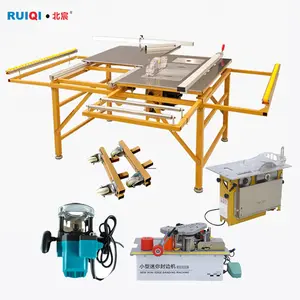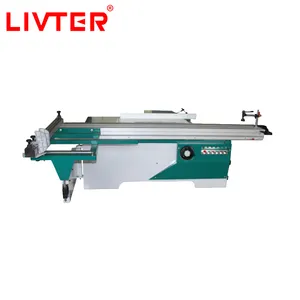ได้รับความนิยมในอุตสาหกรรมของคุณ






จี่ที่ดีที่สุดแผงเลื่อยเครื่องสไลด์ไม้ตารางเห็นที่มีขนาดที่แตกต่างกันตัวเลือกยกอัตโนมัติ
฿59,500.07 - ฿66,937.58
การสั่งซื้อขั้นต่ำ: 1 ชิ้น







การออกแบบตามหลักสรีรศาสตร์และ Stable Multi-Purpose อุปกรณ์ตัดชุด Workbench
฿11,714.08 - ฿12,085.96
การสั่งซื้อขั้นต่ำ: 1 ชิ้น
การจัดส่งต่อชิ้น: ฿4,989.09


ไม้เครื่องจักรไม้เนื้อแข็งไม้อัด MDF แนวนอนตัดแนวตั้งแผงเลื่อย
฿293,781.57 - ฿353,281.63
การสั่งซื้อขั้นต่ำ: 1 ชุด







เลื่อยแผงโต๊ะเลื่อนตัด 45 องศาประสิทธิภาพสูงสําหรับบอร์ด Mdf ไม้
฿92,968.85 - ฿96,687.61
การสั่งซื้อขั้นต่ำ: 1 ชุด







FIXTEC มัลติฟังก์ชั่ไม้ทำงานเครื่องมือไฟฟ้าในครัวเรือน10นิ้วตารางเห็นสำหรับงานไม้
฿3,532.82 - ฿3,718.76
การสั่งซื้อขั้นต่ำ: 4 ชิ้น






MJ6116TD ราคาที่ดีที่สุดสำหรับคู่มือยกมินิไม้เครื่องมือเลื่อนตารางเห็น1600มิลลิเมตร
฿66,937.58 - ฿74,375.08
การสั่งซื้อขั้นต่ำ: 1 ชุด






แบรนด์ใหม่ไม่ได้ใช้1500วัตต์มินิเลื่อนตารางเห็นเครื่อง TS001เครื่องมือตัดไม้
฿4,165.01 - ฿4,425.32
การสั่งซื้อขั้นต่ำ: 50 ชุด






1ชิ้น300มิลลิเมตร-1220มิลลิเมตรมินิ T-Track อลูมิเนียมโลหะผสม T-Slot Jig ตารางการติดตั้งสำหรับเราเตอร์ตารางเห็นเครื่องมืองานไม้
฿39.42 - ฿140.57
การสั่งซื้อขั้นต่ำ: 50 ชิ้น






ไม้วัดมุมขนาดองศา,เครื่องมือช่างแบบมือจับดันมุมสำหรับงานไม้เลื่อยโต๊ะไม้บรรทัดสำหรับช่างไม้
฿922.26 - ฿1,071.01
การสั่งซื้อขั้นต่ำ: 5 ชุด
การจัดส่งต่อชิ้น: ฿217.92






แผงพับทำงานไม้,แผงหน้าปัดเลื่อยไม้แบบ DIY เครื่องมือช่าง
฿200.82 - ฿1,190.01
การสั่งซื้อขั้นต่ำ: 1 ชิ้น
การจัดส่งต่อชิ้น: ฿904.78






เลื่อยวงเดือนสำหรับเลื่อยวงเดือน,เครื่องมืองานไม้ปลอดภัยเลื่อยตัดองศาแบบแมนนวล
฿25,994.10
การสั่งซื้อขั้นต่ำ: 1 ชิ้น
การค้นหาที่เกี่ยวข้อง:
เครื่องมือเลื่อยเลื่อนเครื่องมือเลื่อยขนาดเล็กเครื่องมือเลื่อยเครื่องมือเลื่อยไฟฟ้าชิ้นส่วนเลื่อยมือประเภทเครื่องมือเลื่อยชิ้นส่วนของเลื่อยมือเครื่องมือเลื่อยหลายใบเครื่องมือเลื่อยตัดผู้ผลิตเครื่องมือเลื่อยเครื่องมือเลื่อยไร้สายเครื่องมือชุดเลื่อยวงเดือนเครื่องมือเลื่อยหลายจีนเครื่องมือเลื่อยเลื่อยเครื่องมือที่ดีที่สุด






รางสไลด์แบบที-สล็อตสำหรับงานไม้,รางอลูมิเนียมอัลลอย T-Track Miter Track สำหรับงานไม้เลื่อย/เราเตอร์โต๊ะปรับแต่งประเภท-19
฿37.19 - ฿111.57
การสั่งซื้อขั้นต่ำ: 10 ชิ้น






โต๊ะเลื่อยไม้แบบเลื่อนได้อเนกประสงค์ขนาด2400มม. ม้านั่งสำหรับงานไม้
฿10,784.39 - ฿14,875.02
การสั่งซื้อขั้นต่ำ: 1 ชุด






เลื่อยไม้สองชั้น,เลื่อยแผงเครื่องมือสำหรับงานไม้เลื่อยโต๊ะสไลด์แม่นยำ
฿136,850.15 - ฿143,543.91
การสั่งซื้อขั้นต่ำ: 1 ชุด






เครื่องเลื่อยและโต๊ะเลื่อยอเนกประสงค์แบบเลื่อนได้เครื่องตัดเลื่อยโต๊ะเครื่องมือ SN
฿20,453.15 - ฿21,568.78
การสั่งซื้อขั้นต่ำ: 1 ชุด






อิตาลีโครงสร้างจีนกว่างโจวไม้ขนาดกะทัดรัดแผงเครื่องมือเลื่อนตารางเห็นเครื่อง
฿70,656.33 - ฿92,968.85
การสั่งซื้อขั้นต่ำ: 1 ชุด






เครื่องเลื่อยไม้อเนกประสงค์แบบเลื่อนได้สำหรับมืออาชีพ220V เครื่องมือตัดไม้ใช้ในบ้าน
฿37,187.54
การสั่งซื้อขั้นต่ำ: 1 ชุด






เลื่อยฉลุสำหรับงานหนักผลิตในประเทศจีน,เลื่อยโต๊ะสไลด์เครื่องมือสำหรับงานไม้เครื่องกลึง Cnc เลื่อยวงเดือน
฿57,640.69 - ฿62,772.57
การสั่งซื้อขั้นต่ำ: 1 ชุด




โรงงานขายตรงเครื่องมือเครื่องไม้45/90องศาความแม่นยำเลื่อนตารางเห็นแผงเลื่อย
฿52,703.30 - ฿85,581.92
การสั่งซื้อขั้นต่ำ: 1 ชิ้น
การจัดส่งต่อชิ้น: ฿18,519.40






เครื่องมือเราเตอร์งานไม้,เกจวัดองศาสำหรับเลื่อยโต๊ะแม่นยำพร้อมรั้วปรับองศาอะลูมิเนียม
฿1,524.69 - ฿1,766.41
การสั่งซื้อขั้นต่ำ: 1 ชุด
การจัดส่งต่อชิ้น: ฿866.47






เครื่องมือไฟฟ้า250มิลลิเมตรตารางเลื่อยไฟฟ้าเครื่องไม้ตารางแผงไม้ตัดตัดองศาตารางเลื่อยเครื่อง
฿3,067.98
การสั่งซื้อขั้นต่ำ: 100 ชิ้น






เครื่องมือปรับร่องแบบรูเจาะโต๊ะ,บล็อกวัดความยาวเครื่องมืองานไม้สามารถเคลื่อนย้ายได้
฿682.02 - ฿769.42
การสั่งซื้อขั้นต่ำ: 10 ชิ้น






รั้วไม้สำหรับงานไม้ IVD-3015โต๊ะเลื่อยชุดเครื่องมือสำหรับงานไม้พร้อมเลื่อยวงเดือนและอุปกรณ์ DIY
฿2,491.57 - ฿2,714.70
การสั่งซื้อขั้นต่ำ: 2 ชิ้น
การจัดส่งต่อชิ้น: ฿880.61






ประสิทธิภาพสูงตาราง Saw เครื่องมือไม้พิเศษตัดเลื่อยอเนกประสงค์ยาวขอบตัดอุปกรณ์
฿11,156.27 - ฿22,312.53
การสั่งซื้อขั้นต่ำ: 1 กรณี












Woodfung เครื่องตัดโต๊ะแบบพกพา,ใบมีดขนาดเล็กแบบปรับได้แผงโต๊ะเลื่อนไม่ได้กันฝุ่นเครื่องมือเลื่อยสำหรับงานไม้
฿52,025.37 - ฿74,337.90
การสั่งซื้อขั้นต่ำ: 1 ชุด
















โต๊ะเลื่อยมัลติฟังก์ชั่นทำจากอลูมิเนียมอัลลอยสำหรับงานไม้, โต๊ะเลื่อยขนนก
฿1,301.57 - ฿1,450.32
การสั่งซื้อขั้นต่ำ: 2 ชิ้น
การจัดส่งต่อชิ้น: ฿429.52






ไม้บรรทัดหยุดองศาทำงานไม้แบบปรับได้,ชุดคิตเกจวัดความเที่ยงตรงแม่นยำตัววัดที่พับได้
฿2,230.89
การสั่งซื้อขั้นต่ำ: 1 ชิ้น
การจัดส่งต่อชิ้น: ฿1,248.02






เลื่อยไฟฟ้าขนาดเล็ก220V,เครื่องมือทำงานไม้เสียงรบกวนเล็กๆเลื่อยฉลุ
฿2,194.07 - ฿3,941.88
การสั่งซื้อขั้นต่ำ: 1 ชิ้น






ร้อนขาย Woodfung พีวีซีไม้อัดเครื่องมือตัดเครื่องตัดไม้แนวนอนแบบพกพาตารางเห็น Wtih สองใบมีด MJ09BG
฿59,462.88 - ฿74,337.90
การสั่งซื้อขั้นต่ำ: 1 ชุด






แผงเลื่อยที่มีคุณภาพสูง MJ6132C เครื่องมืองานไม้เลื่อนตารางเห็น/โรงเลื่อย
฿72,515.71
การสั่งซื้อขั้นต่ำ: 1 ชุด



เครื่องตัดแผงไม้แบบแนวตั้งสำหรับงานไม้,เลื่อยวงเดือนเอียงโต๊ะเครื่องเลื่อยสายพานเครื่องมือเครื่องจักร
฿18,593.77 - ฿33,468.79
การสั่งซื้อขั้นต่ำ: 1 ชุด





Miter เลื่อยตั้งโต๊ะอเนกประสงค์,แท่นวางทำงานสำหรับงานไม้เครื่องมืออุตสาหกรรม
฿1,171.41 - ฿1,301.57
การสั่งซื้อขั้นต่ำ: 500 ชิ้น




เลื่อยโต๊ะเลื่อนไม้อเนกประสงค์,เครื่องมือช่างเลื่อยโต๊ะเครื่องจักรงานไม้
฿2,911.79 - ฿3,480.76
การสั่งซื้อขั้นต่ำ: 300 ชิ้น





HY1YD-HK-250A1ขายส่งที่ดีชีวิตยาวไฟฟ้ามัลติฟังก์ชั่เลื่อนเครื่องมือตารางเห็นโต๊ะไม้เห็นสำหรับบ้าน Sierra De Mesa
฿3,718.76 - ฿3,793.13
การสั่งซื้อขั้นต่ำ: 10 ชิ้น






Multi-funciton ไม้ Silding โต๊ะเลื่อยเครื่องมือไฟฟ้าเครื่องจักรงานไม้เลื่อยโต๊ะ
฿69,912.58 - ฿81,068.84
การสั่งซื้อขั้นต่ำ: 1 ชุด






เครื่องมืองานไม้แบบ Diy,รางเกจโลหะแบบเลื่อนได้เห็นตารางทั่วไปสำหรับเราเตอร์
฿981.76 - ฿1,736.66
การสั่งซื้อขั้นต่ำ: 2 ชิ้น
หมวดหมู่ยอดนิยม
เกี่ยวกับ เครื่องมือเลื่อยโต๊ะ
เครื่องมือเลื่อยโต๊ะ ไม่ใช่เรื่องใหม่สำหรับคนทั่วไปในปัจจุบันและไม่ถือว่าเป็นสิ่งต้องห้ามอีกต่อไป หากคุณกำลังมองหาความสุขสุดท้ายนี้คุณต้องตรวจสอบความยิ่งใหญ่ คอลเลกชัน เครื่องมือเลื่อยโต๊ะ ที่ Alibaba.com เหล่านี้ยั่วยวนและโค้ง เครื่องมือเลื่อยโต๊ะ คุ้มค่ากับเงินทุกบาทและมั่นใจว่าจะทำให้ค่ำคืนนี้พิเศษสำหรับคุณ ตุ๊กตาเหล่านี้มีลักษณะเหมือนจริงตั้งแต่ขนไปจนถึงปลายเท้าในทุกแง่มุม
ไม่ว่าคุณจะเป็นคนขี้เหงาที่กำลังมองหาคู่ชีวิตที่เหมือนมีชีวิตหรือคู่รักที่ต้องการเติมชีวิตชีวาให้กับชีวิตคุณสามารถใช้สิ่งเหล่านี้ได้ . เครื่องมือเลื่อยโต๊ะ สำหรับจุดไฟนั้น ที่งดงามเหล่านี้ เครื่องมือเลื่อยโต๊ะ สามารถปรับแต่งได้ตามความคาดหวังของคุณ น่าทึ่งเหล่านี้ เครื่องมือเลื่อยโต๊ะ มีให้เลือกทั้งชายและหญิงและทำจากซิลิโคนเกรดยาเพื่อความปลอดภัยในการใช้งาน รับตอนนี้และเพลิดเพลินไปกับค่ำคืนแห่งความหลงใหลและไฟ
Alibaba.com ขอเสนอสิ่งที่น่าทึ่งเหล่านี้ เครื่องมือเลื่อยโต๊ะ ในทุกรูปร่างขนาดและชาติพันธุ์ ไม่ว่าความต้องการของคุณสำหรับไฟล์. เครื่องมือเลื่อยโต๊ะ คุณสามารถหาได้ทั้งหมดบนไซต์ เหล่านี้ เครื่องมือเลื่อยโต๊ะ ได้รับการขึ้นรูปโดยช่างฝีมือที่ดีที่สุดและทุกรายละเอียดที่ซับซ้อนจะได้รับการตรวจสอบอย่างละเอียด ตุ๊กตาเหล่านี้มีดวงตาผมเล็บและส่วนอื่น ๆ ของร่างกายคล้ายกับคนในชีวิตจริง
Alibaba.com ให้บริการที่หลากหลาย เครื่องมือเลื่อยโต๊ะ ที่สามารถช่วยคุณซื้อผลิตภัณฑ์ที่เหมาะสมกับงบประมาณของคุณและข้อกำหนดอื่น ๆ ผลิตภัณฑ์เหล่านี้ปลอดภัยต่อการใช้งานได้รับการรับรองและเป็นมิตรกับสิ่งแวดล้อม มีคำสั่งซื้อ OEM สำหรับผลิตภัณฑ์เหล่านี้
ไม่ว่าคุณจะเป็นคนขี้เหงาที่กำลังมองหาคู่ชีวิตที่เหมือนมีชีวิตหรือคู่รักที่ต้องการเติมชีวิตชีวาให้กับชีวิตคุณสามารถใช้สิ่งเหล่านี้ได้ . เครื่องมือเลื่อยโต๊ะ สำหรับจุดไฟนั้น ที่งดงามเหล่านี้ เครื่องมือเลื่อยโต๊ะ สามารถปรับแต่งได้ตามความคาดหวังของคุณ น่าทึ่งเหล่านี้ เครื่องมือเลื่อยโต๊ะ มีให้เลือกทั้งชายและหญิงและทำจากซิลิโคนเกรดยาเพื่อความปลอดภัยในการใช้งาน รับตอนนี้และเพลิดเพลินไปกับค่ำคืนแห่งความหลงใหลและไฟ
Alibaba.com ขอเสนอสิ่งที่น่าทึ่งเหล่านี้ เครื่องมือเลื่อยโต๊ะ ในทุกรูปร่างขนาดและชาติพันธุ์ ไม่ว่าความต้องการของคุณสำหรับไฟล์. เครื่องมือเลื่อยโต๊ะ คุณสามารถหาได้ทั้งหมดบนไซต์ เหล่านี้ เครื่องมือเลื่อยโต๊ะ ได้รับการขึ้นรูปโดยช่างฝีมือที่ดีที่สุดและทุกรายละเอียดที่ซับซ้อนจะได้รับการตรวจสอบอย่างละเอียด ตุ๊กตาเหล่านี้มีดวงตาผมเล็บและส่วนอื่น ๆ ของร่างกายคล้ายกับคนในชีวิตจริง
Alibaba.com ให้บริการที่หลากหลาย เครื่องมือเลื่อยโต๊ะ ที่สามารถช่วยคุณซื้อผลิตภัณฑ์ที่เหมาะสมกับงบประมาณของคุณและข้อกำหนดอื่น ๆ ผลิตภัณฑ์เหล่านี้ปลอดภัยต่อการใช้งานได้รับการรับรองและเป็นมิตรกับสิ่งแวดล้อม มีคำสั่งซื้อ OEM สำหรับผลิตภัณฑ์เหล่านี้

















